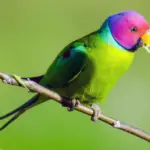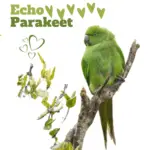Slaty headed parakeet 39–41 cm. Upper mandible red-tipped yellow, lower yellow; head slate grey with black half-collar from chin and throat upsides of neck;
body yellowish green tinged bluish on upper parts; wings green with a maroon patch on lesser wing-coverts; tail green basally shading through blue to yellow distally. Immature green with cheeks brownish, bill greyish.
Systematics History
Slaty headed parakeet Formerly considered conspecific with P. finschii (which see). Artificial hybrids of present species and P. cyanocephala have been shown to be responsible for the form treated in HBW as P. intermedia. Monotypic.
Subspecies
Monotypic.
Distribution
Himalayas from NE Afghanistan and N Pakistan E through N India and Nepal at least to Bhutan; recently recorded in Zhangmu (Tibet), next to the Nepalese border.
Habitat

Movement
Nomadic in E Afghanistan, but elsewhere clear movements occur to lower-lying areas in winter, often first targeting cultivated areas, and in Pakistan, the period spent on breeding grounds is Mar–Aug.
SOURCE: HASSAN AVES
Diet and Foraging
Camphor (Cinnamomum), Cornus, Viburnum and Duranta berries, acorns of Quercus dilatata, seeds of Rhus cotinus, Terminalia myriocarpa and Populus ciliata, flowers of Bauhinia purpurea, Woodfordia fruticosa, Bombax ceiba and Pistacia integerrima, and pods of Dalbergia. In some places, birds raid walnut, apple, and pear orchards, and cornfields.
Sounds and Vocal Behavior
The commonest vocalization Slaty headed parakeet is a strident up slurred or over slurred whistle usually with a very grating start “krreEEh!” (shriller than P. finschii). When perched also utters short phrases with more melodious notes mixed in.
Breeding
Mar–Jul, staggered with altitude. In Afghanistan, old nesting holes of Scaly-bellied Woodpecker (Picus squamatus) are commonly used, while in Pakistan use of Quercus dilatata is common; usually colonial. Slaty headed parakeet Eggs 3–5; in captivity, incubation 24 days, nestling period c. 40 days.
Slaty headed parakeet Not globally threatened. CITES II. Generally common, but apparently very poorly documented in recent decades; uncommon in China.






















